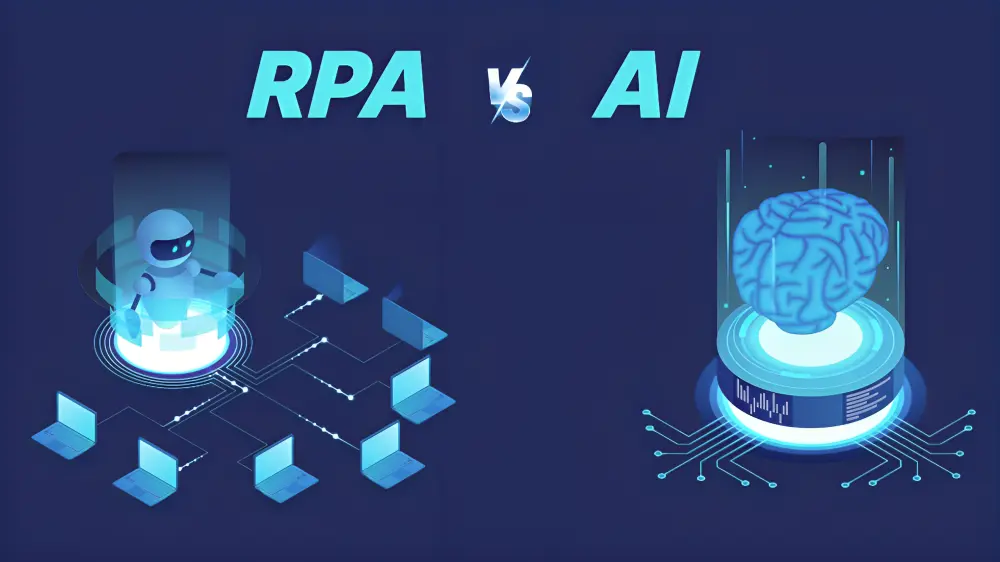increased output. heightened effectiveness. Savings on costs. Business automation technologies are well known for their benefits. In practice, though, business owners are unsure about which automation technology to employ. This essay aims to clarify RPA vs AI, two of the most widely used forms of business automation. You’ll discover the main distinction between the two and how your company can profit from each. This is a thorough comparison of RPA vs AI.
Understanding RPA vs AI
What is RPA?
A group of technologies known as robotic process automation (RPA) aids in the automation of dependable, rule-based business processes. Workflows in businesses involve a lot of tasks. Certain tasks necessitate human judgment and decision-making. Many, though, are predictable and repeatable. RPA is used to automate this second category.
Nowadays, a lot of the software we use and love is rule-based. Computers are very good at quickly and accurately executing clear instructions. They can work tirelessly to process information and complete tasks as long as we give them the proper instructions.
RPA functions similarly. But, it shines and benefits companies when these same features are extended to various databases, systems, and applications. RPA, in short, communicates with different applications in the same manner as a human would. It can replicate the keystrokes, clicks, and mouse movements made during human-computer interactions and learn these actions as a sequence of commands that are executed in response to a trigger or specific circumstance.
Examples of RPA technology
- API integration
- GUI recording tools
- No-code interfaces
- Digital robots or “bots”
- Cross-platform scripting
- Cross-application scripting
What is AI?
A group of technologies known as artificial intelligence (AI) imitate human thought processes. Learning, reasoning, self-correction, object recognition, decision-making, and prediction are a few of these mental tasks. Although this area of computer science has existed since the 1950s, significant progress has been made in the last ten to fifteen years.
Artificial Intelligence is applied everywhere. Though the headlines are dominated by driverless cars, virtual assistants such as Siri and Alexa, and predictive text, generative AI also powers more mundane but useful applications like search engines, cybersecurity, fraud prevention, personalized marketing and recommendations, and data analytics.
Narrow AI is the term used to describe the AI we currently have. To put it briefly, it mimics human intelligence in specific domains, like speech recognition software or Deepmind’s AlphaGo. It is anticipated that AI will eventually transition from specialization to more general intelligence that can manage a wider variety of tasks.
Examples of AI technology
- Generative AI
- Deep learning
- Machine learning
- Predictive analysis
- Computer vision technology
- Natural language processing
The Power of AI in Business Innovation
- Advanced-Data Analysis: Data analysis is one of the most important uses of AI. AI technology can find correlations between variables by sifting through enormous volumes of data. It can identify patterns, anomalies, and trends that a human data analyst might have missed otherwise. Furthermore, using AI instead of humans to analyze data results in better consistency and precision, which can be challenging to achieve with human input.
- Predictive Modeling: AI takes great pride in its ability to instantly analyze massive amounts of data. This provides business owners with insightful information about ongoing operations, enabling them to make better decisions. Take a look at how AI is being used in the finance industry to put things into perspective. Businesses that use AI-powered financial systems can analyze enormous volumes of client data at once. They can find areas to reduce risk and save costs by doing this.
- Enhanced Decision-making: AI takes great pride in its ability to instantly analyze massive amounts of data. This provides business owners with insightful information about ongoing operations, enabling them to make better decisions. Take a look at how AI is being used in the finance industry to put things into perspective. Businesses that use AI-powered financial systems can analyze enormous volumes of client data at once. They can find areas to reduce risk and save costs by doing this.
Applications of AI
- Cybersecurity
- Personalization
- Fraud detection
- Predictive analysis
- Autonomous vehicles
- Marketing automation
- Facial recognition software
- Pharmaceutical drug design
- Customer service chatbots
Applications of RPA
- KYC automation
- Report generation
- Data entry and migration
- Applicant tracking systems
- Automated software testing
- Employment or credit checks
- Customer and employee onboarding
RPA vs AI: Key Differences and Synergies
Configuration: RPA systems are made to function by adhering to set rules. In essence, to enable ingrained capabilities, users must configure specific rules. Complex programming is needed for AI systems. Nevertheless, after they’re configured, they can function independently.
Adaptability: RPA vs AI solutions are both flexible. The kind and degree of flexibility, however, varies greatly. RPA requires human intervention to change any aspect of the system. On the other hand, AI systems can automatically adapt based on recorded data and past experiences.
Conclusion
While increasing operational efficiency and automating tasks are goals shared by both RPA vs AI, their applications are different and their features differ. While AI excels at handling complex, unstructured data and tasks requiring cognitive abilities, RPA excels at automating repetitive, rule-based processes. For organizations to effectively leverage automation and intelligence in their operations, they must comprehend these distinctions. Businesses in the modern digital era can increase productivity, innovation, and competitiveness by strategically utilizing both RPA vs AI technologies.





